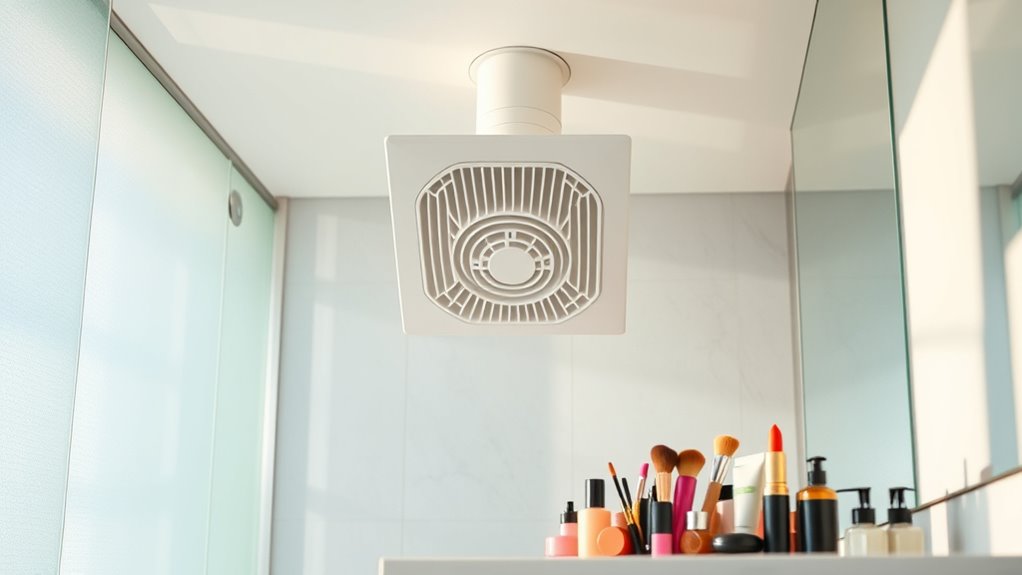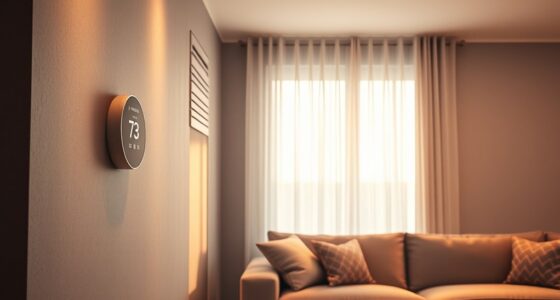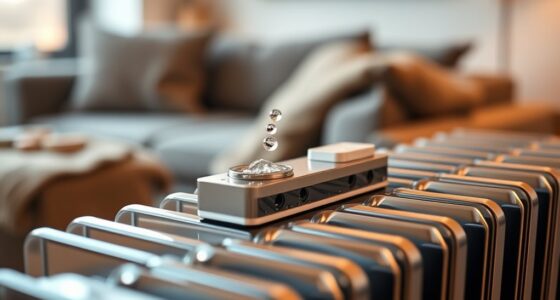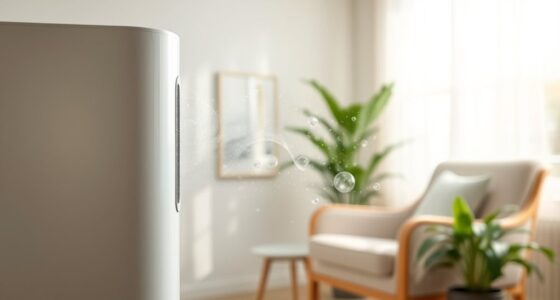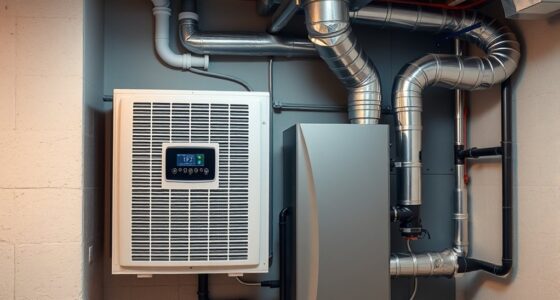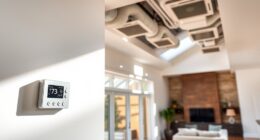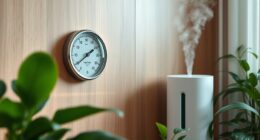Make-up air matters because it balances exhaust systems and keeps your indoor air fresh and safe. Without enough make-up air, you’ll create negative pressure, leading to backdrafting of dangerous gases and indoor pollutants. Properly managing air intake ensures your ventilation system works effectively, preventing stuffy environments and potential structural issues. If you want to understand how to optimize your ventilation and protect your space, there’s more important information ahead.
Key Takeaways
- Make-up air replenishes indoor air lost through exhaust systems, maintaining proper ventilation balance.
- Insufficient make-up air causes negative pressure, backdrafting, and indoor pollutant buildup.
- Proper air intake design ensures safe, healthy indoor environments by balancing airflow.
- Poor management of make-up air can lead to stuffy spaces, odors, and potential structural damage.
- Advanced systems and passive solutions optimize make-up air flow, enhancing overall ventilation efficiency.
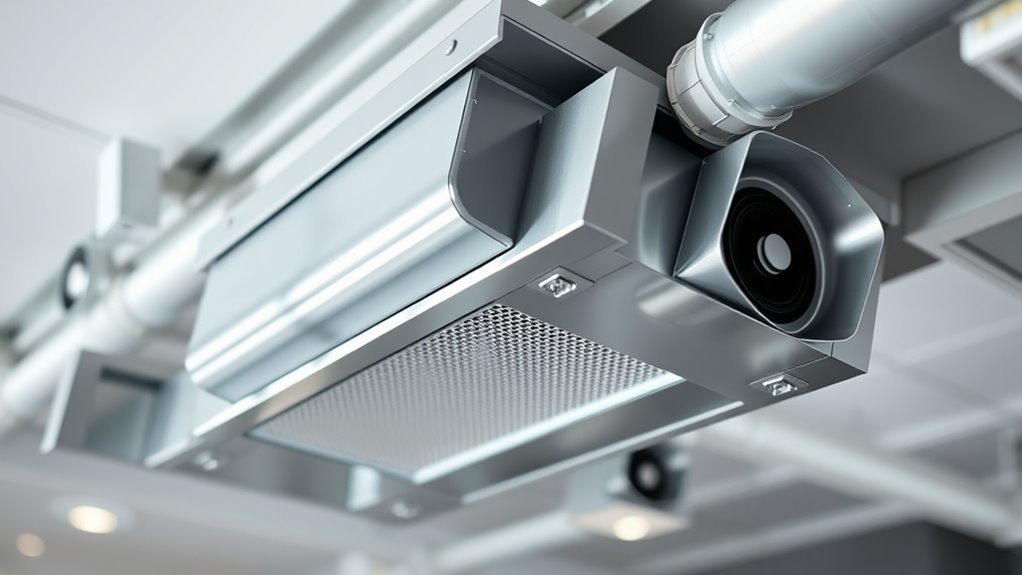
Make-up air is the fresh air brought into a building to replace air that’s exhausted or removed through ventilation systems. When you think about maintaining healthy indoor air quality, it’s easy to overlook how vital make-up air truly is. Without it, your ventilation system can’t operate effectively, leading to imbalanced air pressure and poor indoor conditions. To keep your building comfortable and safe, you need to understand how proper air intake supports a balanced ventilation system.
The concept of air intake is fundamental in ensuring your ventilation balance is maintained. Every time your exhaust system pulls air out—whether for removing fumes, odors, or excess humidity—an equal amount of fresh air must enter the space. If this doesn’t happen, negative pressure builds up inside the building, which can cause issues like backdrafting of dangerous gases or unintentional airflow that pulls contaminants in from outside. Proper make-up air ensures that your building breathes naturally and safely, preventing these problems.
You might not realize it, but many buildings suffer from insufficient or poorly managed air intake. When the amount of make-up air is inadequate, your ventilation system struggles to keep indoor air fresh and safe. This imbalance can lead to stuffy environments, increased indoor pollutants, and even structural problems over time. That’s why a well-designed ventilation balance is critical. It requires carefully calibrated make-up air sources, whether through dedicated air intakes, mechanical systems, or passive ventilation, to ensure the incoming air matches the volume of exhausted air. Additionally, integrating advanced AI-powered systems can optimize airflow efficiency and maintain indoor air quality more effectively.
Frequently Asked Questions
How Do I Determine the Right Amount of Make-Up Air Needed?
To determine the right amount of make-up air needed, you should first calculate the air volume your ventilation system moves daily. Guarantee the make-up air balances this airflow to maintain proper ventilation balance. Measure the exhaust rate and match the incoming make-up air accordingly, avoiding negative pressure. Consulting ventilation standards and using specific calculations for your space helps you fine-tune the right amount for safe, efficient airflow.
Can Make-Up Air Systems Be Integrated With Existing Ventilation?
Yes, you can integrate make-up air systems with your existing ventilation to improve air quality. Start by evaluating your current system’s capacity and airflow needs, then choose compatible equipment. Collaborate with professionals to guarantee proper system integration, which helps maintain balanced ventilation, reduces indoor pollutants, and enhances overall air quality. Proper integration ensures your space remains comfortable, safe, and energy-efficient without disrupting your current setup.
What Are the Energy Costs Associated With Make-Up Air Systems?
Energy costs for make-up air systems are like filling a bucket—small leaks can add up over time. You’ll find that these systems impact energy efficiency, especially if not properly designed. A thorough cost analysis helps you weigh expenses against benefits. While initial installation may seem high, optimized systems save money in the long run by reducing overall energy consumption and maintaining air quality.
Are There Specific Building Types That Benefit Most From Make-Up Air?
You’ll find commercial buildings benefit most from make-up air systems since they often require high ventilation rates to handle large occupancy and equipment loads. Residential homes also gain from these systems, especially in tight, energy-efficient designs where natural airflow is limited. By providing controlled fresh air, you improve indoor air quality and prevent negative pressure issues, ensuring both environments stay comfortable and healthy while maintaining energy efficiency.
How Does Make-Up Air Impact Indoor Air Quality and Comfort?
You’ll notice that make-up air improves indoor air quality and comfort by enhancing air circulation and balancing indoor humidity levels. It prevents stale, stuffy air from accumulating and reduces mold growth, creating a healthier environment. Proper make-up air guarantees fresh air enters as exhaust systems remove indoor pollutants, making your space more comfortable and maintaining consistent humidity. This process keeps the air fresh, breathable, and pleasant for everyone inside.
Conclusion
So, next time you think about ventilation, remember that make-up air is the missing piece to keeping your space fresh and safe. Without it, your airflow can’t truly be effective, leaving you with stale air and potential health issues. Don’t you want a ventilation system that works as hard as you do? Make sure you’re paying attention to make-up air, so your environment stays comfortable and healthy—because good ventilation isn’t complete without it.
